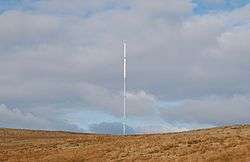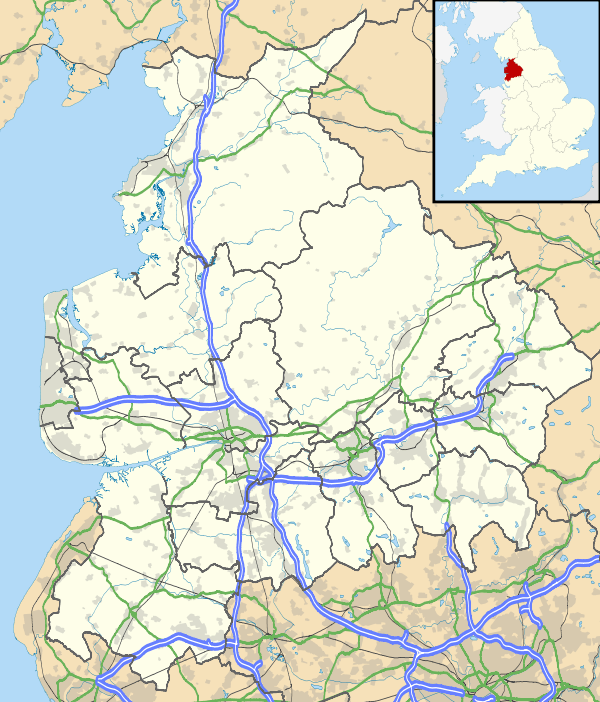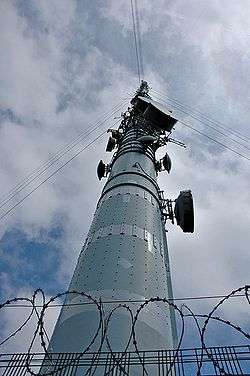Winter Hill transmitting station
 | |
 | |
| Mast height | 309.48 metres (1,015.4 ft) |
|---|---|
| Coordinates | 53°37′32″N 2°30′53″W / 53.6256°N 2.5147°WCoordinates: 53°37′32″N 2°30′53″W / 53.6256°N 2.5147°W |
| Grid reference | SD660145 |
| BBC region | BBC North West |
| ITV region | ITV Granada |
| Local TV service |
Bay TV Liverpool That's Lancashire That's Manchester |
The Winter Hill transmitting station is a broadcasting and telecommunications site on Winter Hill, at the southern boundary of the Borough of Chorley, and above Bolton in Greater Manchester, England. It is owned and operated by Arqiva.
Height
The original mast at Winter Hill was a 140-metre (450 ft) tower that came into service on 3 May 1956, and carried the programmes of Granada ITV (weekdays) and ABC TV (weekends). In 1966 services were transferred to a new higher mast erected adjacent to the original tower. The main mast structure is 309.48 metres (1,015.4 ft) tall and has a diameter of 2.75 metres (9.0 ft). During the period of parallel digital and analogue transmissions, the DTT antenna attached to the top of the mast brought the overall height to 315.4 metres (1,035 ft),[1] however as part of the Digital Switchover plans, this antenna has now been removed, reducing its overall height to 309.48 metres (1,015.4 ft).[1] It is one of the tallest structures in the United Kingdom, the tallest being the mast at Belmont with a height of 351.5 metres (1,153 ft); however, at 778.1 metres (2,553 ft) above sea level, Winter Hill has the highest television transmitting antenna in the United Kingdom and is higher than Gragareth, the highest hill in Lancashire.
Construction

Unlike most masts, which are of a lattice design, Winter Hill mast is of a tubular construction. Five other masts in England share this design (Belmont, Bilsdale, Mendip, Waltham and the original ill-fated structure at Emley Moor). Support wires, to hold the mast vertical, are pitched at 120° when viewed from above. These are connected at 5 heights, giving 15 supports in total. In recent years, these wires have been strengthened, and 152 metric tons (150 long tons) of dampening chains have been fitted by Arqiva (then NTL Broadcast) to reduce the oscillations caused by high winds that were a factor in the collapse of Emley Moor's original structure in 1969. During 2007 - 2009, the mast was strengthened to allow the installation of the new heavier digital transmission aerials.[2]
Maintenance
An advantage of the tubular design is that engineers can ascend the inside the mast and avoid adverse weather, which is a problem on frame structures. Maintaining the outside of the mast is typically performed using a bosun's chair.
The mast has always had a series of red aircraft warning lights but in October 2006 these lights were substantially brightened making the mast far more visible to passing aircraft. These lights can be maintained from the inside, as the lamps swing inwards for maintenance.
Eight external platforms encircle the mast along its height. These can be accessed from the inside of the mast, and are used to maintain the supporting wires, and the ILR antennas.
Coverage
The station's coverage includes approximately 6.3 million people. Although not the 'correct' television region, it is the preferred region for some in North Wales, mainly because it carries Channel 4 (as opposed to S4C, however since digital switchover Channel 4 is also available on all Welsh transmitters), Channel 5 and a much more powerful digital terrestrial output than the Welsh transmitters. The region's ITV franchisees, Granada Television (weekdays only until 1968) and ABC Television (Associated British Corporation) weekends (launched in 1956), were on air much earlier than North Wales' franchisee, WWN (Teledu Cymru) which launched in 1962 (subsequently HTV Wales) giving viewers more choice than they would with the Welsh transmissions. ABC Television lost its franchise in 1968, when Granada Television commenced broadcasting seven days a week. Since the digital switchover, the Welsh transmitters are broadcasting DTT at a much higher power and Channel 4 and Channel 5 are now included in the line-up. However, because of terrain and rough landscapes of North Wales, many will find it easier to stay with Winter Hill (as small local relays will only broadcast a limited range of the digital channels).
In July 2007 it was confirmed by Ofcom that Winter Hill would be remaining a C/D group transmitter after DSO (digital switchover). One of the Winter Hill Multiplexes (Arqiva B or MUX6), broadcasting channels including Film4 and ITV4, was on reduced power (12.5 kW) until Sutton Coldfield went fully digital in September 2011. This compares with the other Winter Hill digital multiplexes which have broadcast with 100 kW since 2 December 2009. This significantly affected the Arqiva B multiplex coverage area until the Sutton Coldfield final switchover.
Apart from North Wales, the coverage area is what is expected, covering a large area of the northwest. More Relay Transmitters appear towards the east in Greater Manchester.
Output

Television
Digital
Winter Hill is the principal transmitter for the Granada region and in 2009 it became the first in the UK to broadcast digital television in high definition.[3][4]
Arqiva B (on channel 55) was originally transmitted at only 12.5 kW to prevent co-channel interference with the Sutton Coldfield transmitting station's Arqiva B, which was on the same channel until it switched over in September 2011. It now transmits at 100 kW, the same power as the other five multiplexes.
Only four of the 70 Winter Hill relays broadcast six digital multiplexes (Lancaster, Saddleworth, Pendle Forest and Storeton). All the others broadcast just the three public service multiplexes BBC A, BBC B and D3&4. Since switchover BBC B is reserved for HD broadcasts only. Winter Hill also broadcasts a Manchester multiplex on Channel 57.
| Frequency | UHF | kW | Operator | System |
|---|---|---|---|---|
| 554.000 MHz | 31 | 25.7 | COM7 (ARQ C) | DVB-T2 |
| 602.000 MHz | 37 | 22.6 | COM8 (ARQ D) | DVB-T2 |
| 698.000 MHz | 49 | 100 | COM5 (ARQ A) | DVB-T |
| 706.000 MHz | 50 | 100 | PSB1 (BBC A) | DVB-T |
| 737.833 MHz | 54- | 100 | PSB3 (BBC B) | DVB-T2 |
| 746.000 MHz | 55 | 100 | COM6 (ARQ B) | DVB-T |
| 754.000 MHz | 56 | 2 | LTVmux (Liverpool) | DVB-T |
| 754.000 MHz | 56 | 1 | LTVmux (Preston) | DVB-T |
| 754.000 MHz | 56 | 2 | LTVmux (Manchester) | DVB-T |
| 762.000 MHz | 57 | 1 | GImux (G_MAN) | DVB-T |
| 770.000 MHz | 58 | 100 | COM4 (SDN) | DVB-T |
| 778.000 MHz | 59 | 100 | PSB2 (D3&4) | DVB-T |
Before switchover
| Frequency | UHF | kW | Operator |
|---|---|---|---|
| 754.166 MHz | 56+ | 10 | BBC (Mux 1) |
| 786.166 MHz | 60+ | 10 | Arqiva (Mux C) |
| 810.166 MHz | 63+ | 10 | Arqiva (Mux D) |
| 834.166 MHz | 66+ | 10 | Digital 3&4 (Mux 2) |
| 842.166 MHz | 67+ | 10 | BBC (Mux B) |
| 850.166 MHz | 68+ | 10 | SDN (Mux A) |
Analogue
Analogue television transmissions from Winter Hill ceased officially early in the morning of 2 December 2009. Since then the site has carried only digital terrestrial television transmissions.
| Frequency | UHF | kW | Service |
|---|---|---|---|
| 615.25 MHz | 39 | — | Channel M |
| 687.25 MHz | 48 | 12.5 | Channel 5 |
| 743.25 MHz | 55 | 500 | BBC One |
| 775.25 MHz | 59 | 500 | ITV1 |
| 799.25 MHz | 62 | 500 | BBC Two |
| 823.25 MHz | 65 | 500 | Channel 4 |
Digital television
The following is a list of the television relays served by Winter Hill, including UHF channels for each multiplex it carries:
| Transmitter | BBC A | D3&4 | BBC B | SDN | ARQA | ARQB | LOCAL |
|---|---|---|---|---|---|---|---|
| Austwick | 45 | 39 | 42 | N/A | N/A | N/A | N/A |
| Backbarrow | 53 | 60 | 57 | N/A | N/A | N/A | N/A |
| Bacup | 46 | 43 | 40 | N/A | N/A | N/A | N/A |
| Barrow Town Hall | 44 | 41 | 47 | N/A | N/A | N/A | N/A |
| Birch Vale | 46 | 43 | 40 | N/A | N/A | N/A | N/A |
| Blackburn | 46 | 43 | 40 | N/A | N/A | N/A | N/A |
| Bollington | 27 | 24 | 21 | N/A | N/A | N/A | N/A |
| Brinscall | 21 | 24 | 27 | N/A | N/A | N/A | N/A |
| Broadbottom | 45 | 42 | 39 | N/A | N/A | N/A | N/A |
| Brook Bottom | 53 | 60 | 57 | N/A | N/A | N/A | N/A |
| Burbage | 47 | 41 | 44 | N/A | N/A | N/A | N/A |
| Buxton | 27 | 24 | 21 | N/A | N/A | N/A | N/A |
| Cartmel | 28 | 25 | 22 | N/A | N/A | N/A | N/A |
| Chaigley | 27 | 24 | 21 | N/A | N/A | N/A | N/A |
| Chatburn | 26 | 23 | 29 | N/A | N/A | N/A | N/A |
| Chinley | 53 | 60 | 57 | N/A | N/A | N/A | N/A |
| Congleton | 44 | 41 | 47 | N/A | N/A | N/A | N/A |
| Dalton | 46 | 43 | 40 | N/A | N/A | N/A | N/A |
| Darwen | 45 | 39 | 42 | N/A | N/A | N/A | N/A |
| Delph | 26 | 23 | 29 | N/A | N/A | N/A | N/A |
| Dog Hill | 46 | 43 | 40 | N/A | N/A | N/A | N/A |
| Elton | 27 | 24 | 21 | N/A | N/A | N/A | N/A |
| Far Highfield | 52 | 56 | 48 | N/A | N/A | N/A | N/A |
| Glossop | 28 | 25 | 22 | N/A | N/A | N/A | N/A |
| Haslingden | 26 | 23 | 29 | N/A | N/A | N/A | N/A |
| Haughton Green | 46 | 43 | 40 | N/A | N/A | N/A | N/A |
| Ladder Hill | 26 | 23 | 29 | N/A | N/A | N/A | N/A |
| Lancaster | 27 | 24 | 21 | 25 | 28 | 22 | N/A |
| Langley | 27 | 24 | 21 | N/A | N/A | N/A | N/A |
| Lees | 28 | 25 | 22 | N/A | N/A | N/A | N/A |
| Littleborough | 27 | 24 | 21 | N/A | N/A | N/A | N/A |
| Macclesfield | 28 | 25 | 22 | N/A | N/A | N/A | N/A |
| Manchester Hulme | 44 | 41 | 47 | N/A | N/A | N/A | N/A |
Radio
FM
| Frequency | kW[5] | Service |
|---|---|---|
| 88.6 MHz | 4† | BBC Radio 2 |
| 90.8 MHz | 4† | BBC Radio 3 |
| 93.0 MHz | 4† | BBC Radio 4 |
| 97.4 MHz | 2 | 97.4 Rock FM |
| 98.2 MHz | 4† | BBC Radio 1 |
| 100.4 MHz | 5 | Smooth Radio |
| 103.9 MHz | 2 | BBC Radio Lancashire |
| 105.4 MHz | 5 | Heart North West |
† Relays the signal from Holme Moss to cover south and central Lancashire [5]
DAB
| Frequency | Block | kW[5] | Operator |
|---|---|---|---|
| 220.352 MHz | 11C | 0.25† | CE Manchester |
| 222.064 MHz | 11D | 10 | Digital One |
| 223.936 MHz | 12A | 1.5‡ | Bauer Central Lancashire |
| 225.648 MHz | 12B | 10 | BBC National DAB |
† Broadcasts from a directional aerial to cover Greater Manchester.
‡ Broadcasts from a directional aerial to cover central Lancashire (Wigan, Preston, Southport, Blackpool and surrounding areas).
Plane crash
On 27 February 1958, a Silver City Bristol 170 Freighter (G-AICS) travelling from the Isle of Man to Manchester crashed into Winter Hill (also known as Rivington Moor) several hundred yards away from the mast. Thirty-five people died and 7 were injured. The weather that night was so severe that none of the engineers working in the transmission centre were aware of the crash. Several feet of snow hampered rescue efforts, and a snowcat vehicle had to be diverted from the A6 to cut a path for emergency vehicles.
Timeline
- 1956: Granada Television weekdays & ABC Television (Associated British Corporation) weekends commence black and white television broadcasting prior to main mast construction.
- 1958: Fatal plane crash kills 35 people, 7 survive.
- 1962: BBC commence broadcasting.
- 1965: Main mast is completed, replacing the old 450' construction, which is removed.
- 1965: BBC2 UHF transmissions start.
- 1967: BBC2 UHF Colour Transmissions start.
- 1968: ABC Television loses franchise; Granada Television commences broadcasting seven days a week.
- 1968: ITA (Independent Television Authority) build the single storey engineering building.
- 1969: ITV and BBC1 transmit in colour on UHF.
- 1970: Relaying service set up with Emley Moor mast.
- 1974: Local radio stations set up wire frame ILR transmitters on the hill. ITA became IBA, following start of commercial radio broadcasting (in 1973).
- 1981: Channel 4 create additional engineering building.
- 1981: Occasional Channel 4 test transmissions start.
- 1982: Additional ILR transmitter put into operation for further local radio. Channel 4 commences transmission (on 2nd November 1982 at 5pm with COUNTDOWN).
- 1983: Channel 4 set up relay service.
- 1989: NICAM stereo transmissions commence from the site.
- 1997: Channel 5 commences transmission
- 1998: Century FM radio starts broadcasting from the main mast (became Real Radio, now HEART).
- 1998: Low power Digital TV transmission start.
- 2009: Analogue TV signals were switched off in two phases on Wednesday 4 November 2009 (BBC Two Switched off) and 2 December 2009 (remaining analogue channels).[6]
See also
- List of masts
- List of tallest structures in the United Kingdom
- List of radio stations in the United Kingdom
References
- 1 2 Chorley Council - Planning Applications - Ref: 07/00056/FUL
- ↑ The Transmission Gallery - Winter Hill
- ↑ "Freeview set for HD channels". Ofcom. Retrieved 2008-10-19.
- ↑ "Ofcom confirms three Freeview HD channels 'by end of next year' • The Register". www.theregister.co.uk. Retrieved 2008-10-19.
- 1 2 3 Radio Listeners Guide
- ↑ "Digital UK - Granada TV Region". www.digitaluk.co.uk. Retrieved 2008-10-19.
Further reading
- The Devil Casts His Net, Steve Morrin, ISBN 0-9534503-1-7, The Winter Hill Air Disaster.
External links
| Wikimedia Commons has media related to Winter Hill. |
- MB21 Winter Hill index.
- Info and pictures of Winter Hill including co-receivable transmitters.
- http://www.skyscraperpage.com/diagrams/?b2455
- Winter Hill Transmitter at thebigtower.com